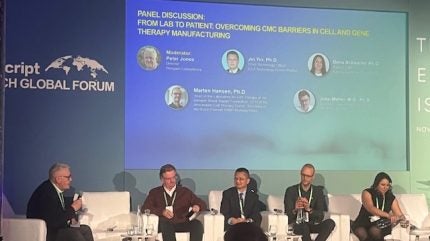
Since their inception, cell and gene therapies (CGTs) have shown great promise in treating a plethora of challenging diseases.
Despite their burgeoning potential, CGT developers face a bumpy road from concept to commercialisation.

Discover B2B Marketing That Performs
Combine business intelligence and editorial excellence to reach engaged professionals across 36 leading media platforms.
Throughout the process, companies must contend with early-stage hurdles such as trial and assay design, as well as high manufacturing and commercialisation costs and supply chain challenges.
In the world of CAR-T – one of the most renowned forms of CGT – Dr John Maher, scientific founder and CSO of Leucid Bio, noted that starting material can be subject to significant batch-to-batch variation, while manufacturing processes remain “cumbersome”, requiring vast amounts of paperwork.
Jin Yin, CTO of ProBio’s CGT Technology Center, echoed Maher’s sentiments but noted that the key challenge he sees is the “low clinical success rate,” which he calculated at less than 2%.
At the GenScript Biotech Global Forum London, hosted in 116 Pall Mall on 20 November, experts from across the cell and gene therapy (CGT) sector agreed that while there are significant challenges associated with development and commercialisation, there are ways in which companies can boost their chances of success.

US Tariffs are shifting - will you react or anticipate?
Don’t let policy changes catch you off guard. Stay proactive with real-time data and expert analysis.
By GlobalDataShifting focus to early-stage development
According to the panel, one way to overcome chemistry, manufacturing and control (CMC) issues is to refine early-stage research for long-term success.
To achieve this, Maher believes the industry should “move away from traditional xenograft animal models to demonstrate preclinical efficacy”, as more advanced assays like organ-on-a-chip come to the forefront.
The US Food and Drug Administration (FDA) seems to agree with this sentiment, as its April 2025 framework aims to phase out animal testing in preclinical studies. Europe and the UK are also pushing towards a reduction in animal testing in the preclinical stage.
Meanwhile, Yin noted that more investment should be placed into earlier target selection, with a key focus on efficacy and safety.
“We need to have a really good idea of what we’re trying to achieve with a CGT product, and what that product should look like,” commented Dr Dima Al-Hadithi, Partner-CMC at RareGenix/Minaret Consulting.
All panellists also highlighted the importance of designing a target profile with the endgame in mind.
Maher also stressed the importance of communication in setting up for success. “We need the R&D department to be talking to the CMC portion of the business, which will help embed CMC practices – even at the development stage,” he said.
Once a CGT product reaches the commercial stage, Maher suggests that companies employ a commercial strategy that reduces risk from a reimbursor’s perspective. This could be achieved via “performance-related payments or a money-back guarantee scheme”.
Considering outsourcing for CGT development
While the CGT development process is often highly costly, Yin mentioned that using contract development and manufacturing organisations (CDMOs) can help relieve this financial burden.
“By using a CDMO, you can pay a small portion of money to utilise their cell bank compared with the costs of developing your own. This can then be used for clinical trials to start with, meaning if you fail, you don’t lose a lot of money,” he commented.
Al-Hadithi said that a company must decide whether it’s better to employ one CDMO for all parts of the manufacturing process, or if a company should have its own facility.
However, in the early stages, Al-Hadithi remarked that operations should remain lean, which means companies may benefit from using a CDMO as an “extension to the team”.
Automation key in mitigating CMC challenges
Automation technologies like artificial intelligence (AI) have exploded onto the pharma scene, with their use cases extending through to everything from discovery and R&D to the manufacturing and commercial settings.
Moving forward, Maher believes that the future of CGT should see “fewer humans, less paperwork and more automation”.
“AI and machine learning can inform the manufacturing process, while also overseeing the quality control analysis,” he said. Yin echoed this sentiment, noting that AI could show particular promise in streamlining the vector design process.
Al-Hadithi suggested that digitalisation will not only be big for the industry, but also for regulators. “I think we’re going to see more scrutiny of dossiers go in that way, and maybe at some point, we might see more digitalised CMC submissions,” she commented.
Though Al-Hadithi agreed that AI can drive efficiencies, she caveated that these technologies often come with legal hurdles that must be negotiated.
“AI technologies come with licensing fees, and duplication on IP can also be an issue, so it can take a lot of time to start to negotiate these types of contracts,” Al-Hadithi concluded.





